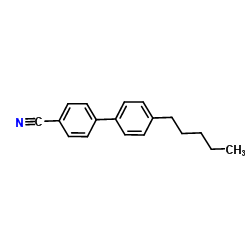5CB

5CB structure
|
Common Name | 5CB | ||
|---|---|---|---|---|
| CAS Number | 40817-08-1 | Molecular Weight | 249.350 | |
| Density | 1.0±0.1 g/cm3 | Boiling Point | 361.6±0.0 °C at 760 mmHg | |
| Molecular Formula | C18H19N | Melting Point | 34 °C | |
| MSDS | Chinese USA | Flash Point | 193.5±17.3 °C | |
| Symbol |

GHS07 |
Signal Word | Warning | |
|
A simple quantitative method to study protein-lipopolysaccharide interactions by using liquid crystals.
ChemPhysChem 16(4) , 753-60, (2015) The interaction of proteins with endotoxins has divergent effects on lipopolysaccharide (LPS)-induced responses, which serve as a basis for many clinical and therapeutic applications. It is, therefore, important to understand these interactions from both theo... |
|
|
Creation and manipulation of topological states in chiral nematic microspheres.
Nat. Commun. 6 , 7603, (2015) Topology is a universal concept that is encountered in daily life and is known to determine many static and dynamical properties of matter. Taming and controlling the topology of materials therefore constitutes a contemporary interdisciplinary challenge. Buil... |
|
|
Nematic director reorientation at solid and liquid interfaces under flow: SAXS studies in a microfluidic device.
Langmuir 31(14) , 4361-71, (2015) In this work we investigate the interplay between flow and boundary condition effects on the orientation field of a thermotropic nematic liquid crystal under flow and confinement in a microfluidic device. Two types of experiments were performed using synchrot... |
|
|
Doping the nematic liquid crystal 5CB with milled BaTiO3 nanoparticles.
Phys. Rev. E. Stat. Nonlin. Soft Matter Phys. 86(5 Pt 1) , 051704, (2012) The simple nematic mesogen 5CB was doped with milled BaTiO3 nanoparticles and was investigated with x-ray scattering. Doping with BaTiO3 nanoparticles of 9 nm in diameter led to the formation of crystallites. These crystallites precipitated and formed a waxli... |
|
|
Thermotropic interface and core relaxation dynamics of liquid crystals in silica glass nanochannels: a dielectric spectroscopy study.
Phys. Chem. Chem. Phys. 17 , 22115-24, (2015) We report dielectric relaxation spectroscopy experiments on two rod-like liquid crystals of the cyanobiphenyl family (5CB and 6CB) confined in tubular nanochannels with 7 nm radius and 340 micrometer length in a monolithic, mesoporous silica membrane. The mea... |
|
|
Improved pulse schemes for separated local field spectroscopy for static and spinning samples.
Solid State Nucl. Magn. Reson. 33(3) , 57-63, (2008) An improved pulse sequence for SLF experiments based on the magic sandwich (MS) scheme for homo-nuclear dipolar decoupling is proposed. The sequence incorporates a double MS, both on I and S spins and has been named as EXE-MS2. The proposed scheme which has a... |
|
|
A simple strategy to monitor lipase activity using liquid crystal-based sensors.
Talanta 99 , 36-9, (2012) In this study, we developed a simple label-free technique for monitoring the enzymatic activity of lipase using liquid crystal (LC)-based sensors. The optical response of LCs changed from a bright to dark appearance when an aqueous solution of lipase was in c... |
|
|
Capillary-induced giant elastic dipoles in thin nematic films.
Proc. Natl. Acad. Sci. U. S. A. 112 , 14771-6, (2015) Directed and true self-assembly mechanisms in nematic liquid crystal colloids rely on specific interactions between microparticles and the topological defects of the matrix. Most ordered structures formed in thin nematic cells are thus based on elastic multip... |
|
|
Nanoscale interlayer that raises response rate in photorefractive liquid crystal polymer composites.
Opt. Express 19(13) , 12496-502, (2011) By depositing a nanoscale photoconductive layer on a stable photorefractive (PR) polymeric film, consisting of the polymer poly[N-vinylcarbazole] (PVK) doped with 4,4'-n-pentylcyanobiphenyl (5CB) and C60, both the response rate and beam coupling properties we... |
|
|
Using liquid crystals for the label-free detection of catalase at aqueous-LC interfaces.
J. Biotechnol. 157(1) , 223-7, (2012) In this study, we developed a simple label-free method for the detection of catalase (CAT) using liquid crystals (LCs). The optical appearance of LCs changed from bright to dark when hydrogen peroxide was in contact with the dodecanal-doped nematic LC, 4-cyan... |